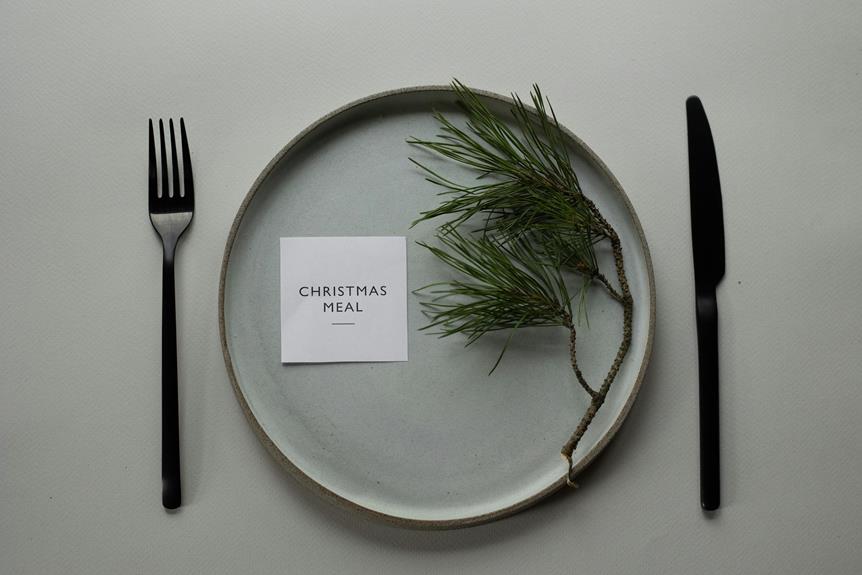You owe the existence of Christmas cards to Sir Henry Cole, a Victorian entrepreneur who pioneered the concept of sending festive greetings to loved ones in a convenient and affordable way. In 1843, Cole designed and printed the first Christmas card, featuring a colorful illustration of a happy family and a heartfelt message. Initially, sales were modest, but Cole continued to market his cards, and eventually, they gained traction. As you unwrap the story of the first Christmas card, you'll discover how Cole's innovative idea sparked a tradition that's been spreading joy and festive cheer for over a century, and how it continues to evolve to this day.
Key Takeaways
- Sir Henry Cole, a Victorian entrepreneur, created the first Christmas card in 1843 to save time and make holiday greetings more affordable.
- Cole's innovative design featured a colorful illustration of a happy family enjoying a festive meal and a simple yet heartfelt message.
- The first Christmas cards were printed on high-quality paper, hand-colored, and standardized in size to make them easier to produce and mail.
- Initially, sales were modest, but Cole continued to market his cards, and they eventually gained popularity and became a staple of the holiday season.
- The tradition of sending Christmas cards revolutionized the way people celebrated Christmas, allowing them to connect with loved ones and share in the holiday spirit.
The Birth of a Tradition
As you explore the history of Christmas cards, you'll discover that the concept of sending festive greetings originated in Victorian England, where a clever British artist and inventor named Sir Henry Cole sparked a tradition that would soon spread across the globe.
During the Victorian Era, social etiquette was of utmost importance, and exchanging Christmas cards became an essential part of the holiday season. It was a way to connect with loved ones, strengthen social bonds, and showcase one's refinement and taste.
The cultural significance of Christmas cards lay in their ability to convey warmth, kindness, and generosity. They allowed people to express their feelings and sentiments in a more personal and intimate way.
As the tradition gained popularity, Christmas cards became a window into the values and aesthetics of the time. They reflected the Victorian Era's love for ornate designs, rich colors, and sentimental poetry.
Sir Henry Cole's Brilliant Idea
You're about to uncover the fascinating story of how Sir Henry Cole's innovative thinking revolutionized the way people celebrated Christmas.
A Victorian entrepreneur and postal pioneer, Cole was always looking for ways to improve communication and make people's lives easier.
In the mid-1800s, Cole was working at the British Postal Service, where he noticed that people were struggling to find the time to write personalized Christmas greetings to their loved ones.
He realized that a pre-designed card with a festive message would be the perfect solution.
Cole's brainstorm sparked a brilliant idea – to create a Christmas card that people could simply sign and send.
This wouldn't only save time but also make it more affordable for people to send holiday greetings.
With his entrepreneurial spirit, Cole saw an opportunity to create a new market and capitalize on the growing popularity of Christmas celebrations.
His innovative thinking paved the way for a new tradition, one that would bring people together and make the holiday season more joyful.
Cole's brilliant idea was about to change the way people celebrated Christmas forever.
Cole's Design and Message
Sir Henry Cole's design for the first Christmas card featured a colorful illustration of a happy family enjoying a festive holiday meal, accompanied by a simple yet heartfelt message: 'A Merry Christmas and a Happy New Year to You.'
This design perfectly captures the essence of the Victorian Aesthetic, which emphasized beauty, elegance, and refinement. Cole's artistic expression is evident in the intricate details and vibrant colors used in the illustration, evoking a sense of warmth and joy.
The message itself is a masterclass in simplicity and sincerity, conveying the true spirit of the season.
Cole's use of a generic greeting, rather than a personalized one, was a deliberate choice, making the card accessible to a wider audience.
This clever move helped pave the way for the mass production of Christmas cards, which would soon become a beloved tradition.
As you gaze upon this pioneering design, you can't help but appreciate Cole's innovative spirit and his contribution to the world of festive greetings.
The First Printed Cards
Sir Henry Cole's innovative design and message sparked a new era in festive greetings, and in 1843, he took the next step by printing a batch of these cards, making him the first to mass-produce Christmas cards.
His printed cards were successful due to several key factors.
High-quality paper was chosen, which could withstand the rigors of postal travel and still look elegant upon arrival.
Colorful illustrations featured beautiful, hand-colored illustrations that added a touch of festive cheer to the design.
Affordable printing costs were achieved by printing a large batch of cards, reducing the printing costs and making the cards more affordable for the average person.
Standardized size was introduced, making the cards easier to produce and mail.
Initial Reception and Sales
When Cole's printed Christmas cards hit the market, they sparked a mix of curiosity and skepticism among the public, with some people embracing the innovative idea and others questioning its practicality.
You might've wondered if this new concept would catch on or if it was just a fleeting novelty.
The market reaction was indeed varied, with some hailing it as a convenient and thoughtful way to send holiday greetings, while others saw it as an unnecessary expense.
As you looked at the sales projections, it was clear that Cole's cards weren't an overnight sensation.
Initially, the sales were modest, with only a few thousand cards sold in the first year.
However, Cole didn't give up.
He continued to market his cards, and slowly but surely, they started to gain traction.
You could sense a growing interest in the idea, and sales began to pick up.
Although it wasn't a massive success right away, Cole's perseverance paid off, and the Christmas card industry started to take shape.
The Rise of Christmas Cards
As the novelty of printed Christmas cards wore off, their popularity began to soar, with Cole's designs capturing the essence of the holiday season and resonating with the masses.
You might be wondering what contributed to their rapid rise in popularity.
Mass production: With advances in printing technology, it became possible to produce large quantities of cards quickly and efficiently. This made them more accessible and affordable for the general public.
Cultural significance: Christmas cards began to take on a deeper meaning, serving as a way to connect with loved ones and share in the holiday spirit. They became an integral part of the holiday tradition.
Increased postal services: As postal services expanded and improved, it became easier and more convenient to send cards to friends and family.
Marketing and advertising: Clever marketing and advertising campaigns helped to promote Christmas cards, making them a staple of the holiday season.
As you can see, it was a combination of these factors that contributed to the rapid rise of Christmas cards.
You can't help but wonder what the future holds for this beloved holiday tradition.
Competitors and Imitators
You didn't have to look far to find others capitalizing on Cole's innovative idea, as a slew of competitors and imitators emerged to claim a piece of the lucrative Christmas card market.
These new entrants adopted imitation strategies, copying Cole's design and production methods to create their own versions of Christmas cards.
As a result, the market became saturated with similar products, making it increasingly difficult for consumers to distinguish one brand from another.
You might think that Cole would've been concerned about the competition, but he wasn't.
In fact, he saw it as an opportunity to innovate further and stay ahead of the game.
Cole continued to experiment with new designs, materials, and production techniques, ensuring that his cards remained unique and of high quality.
By doing so, he maintained his position as a market leader, even as the competition grew fiercer.
As you'll see, Cole's ability to adapt and innovate would be vital in shaping the future of the Christmas card industry.
The Impact on Holiday Celebrations
Cole's innovative Christmas cards soon became an integral part of holiday celebrations, allowing people to express their festive cheer in a way that felt both personal and convenient. As you prepared for the holiday season, you no longer had to worry about finding the time to write individual letters to loved ones or struggle with the perfect phrase to express your holiday wishes. With Christmas cards, you could easily send a heartfelt message to friends and family, saving you time and reducing holiday stress.
Christmas cards made it easy to send a thoughtful message to multiple people at once, freeing up time for more important things… like baking cookies!
By sending cards to loved ones near and far, you could feel more connected to family during the holiday season, even if you couldn't be together in person.
Christmas cards became a fun activity to work on together as a family, allowing you to bond over the creation of a special holiday message.
The tradition of sending Christmas cards sparked new holiday customs, such as displaying cards on a mantle or in a special album.
With Christmas cards, you could focus on what truly mattered – spending time with loved ones and enjoying the festive spirit of the season.
The Evolution of Card Design
From humble beginnings featuring simple illustrations and generic messages, Christmas card design has undergone a remarkable transformation over the years, reflecting shifting cultural values, artistic trends, and technological advancements.
As you explore the history of Christmas cards, you'll notice a gradual shift from traditional illustrations to more modern and innovative designs.
In recent years, digital illustrations have become increasingly popular, allowing artists to create intricate and detailed designs with ease. You've probably received Christmas cards with 3D effects, holographic finishes, or even augmented reality features.
These advancements have opened up new possibilities for designers, enabling them to push the boundaries of creativity.
Material innovations have also played a significant role in the evolution of Christmas card design. You might've seen cards made from recycled materials, embossed with foil stamping, or even featuring die-cut designs.
These developments haven't only enhanced the aesthetic appeal of Christmas cards but also made them more sustainable and eco-friendly.
As you continue to send and receive Christmas cards, keep an eye out for the latest trends and innovations that are sure to make your holiday greetings stand out.
A Lasting Holiday Legacy
As Christmas cards continue to evolve, they've become a treasured part of our holiday traditions, allowing us to share love, laughter, and memories with loved ones near and far. You may not realize it, but the Christmas cards you send or receive today are a part of a rich legacy that's been passed down through generations.
Many families treasure vintage Christmas cards as precious family heirlooms, often displaying them alongside other holiday decorations.
You can create personalized Christmas cards that reflect your family's unique style and traditions, making each year's card a special keepsake.
Christmas cards often tell a story, whether it's a photo of your growing family, a update on your year, or a heartfelt message to loved ones.
Christmas cards can evoke powerful emotions and memories, transporting you back to a specific time and place in your life.
As you send or receive Christmas cards this year, remember the lasting legacy they represent – a tradition that connects us to our past, present, and future.
Frequently Asked Questions
Were Christmas Cards Only Sent to the Wealthy in the Early Days?
You might think that, initially, Christmas cards were only sent to the wealthy, and you're right! In the early days, they were a luxury only the affluent could afford, reinforcing social hierarchy and economic exclusivity.
Can I Find an Original 1843 Christmas Card for Sale Online?
"Are you ready to strike gold? You can try searching for rare finds on online marketplaces like eBay or Etsy, but be prepared for a potentially fruitless search, as original 1843 Christmas cards are extremely scarce."
Did Sir Henry Cole Invent the Concept of Greeting Cards?
You're wondering if Sir Henry Cole invented the concept of greeting cards. While he didn't, he did pioneer mass production of cards, combining his artistic vision with innovative printing techniques to make them accessible to the masses.
Were Christmas Cards Initially Meant to Be Humorous or Serious?
You scroll through your Instagram feed, and suddenly, you're wondering: were Christmas cards initially meant to be humorous or serious? Well, back in the day, Victorian humor was all about holiday satire, so yeah, they were definitely meant to be cheeky and playful!
Did the Rise of Christmas Cards Lead to a Decline in Letter Writing?
You might think that Christmas cards replaced handwritten letters, but they actually complemented them, offering a new way to express emotional sentiments. Later, digital alternatives emerged, further changing how you share holiday cheer.
Conclusion
As you hold a Christmas card in your hand, remember you're part of a tradition that's been 'decking the halls' for over a century.
Like Dickens' Ghost of Christmas Past, Sir Henry Cole's innovative spirit whispers to us from the Victorian era, reminding us of the joy and love that sparked this festive tradition.
Today, as you send or receive a holiday greeting, you're a thread in the rich tapestry of history, weaving a narrative of love, kindness, and connection that will continue to unfold for generations to come.


